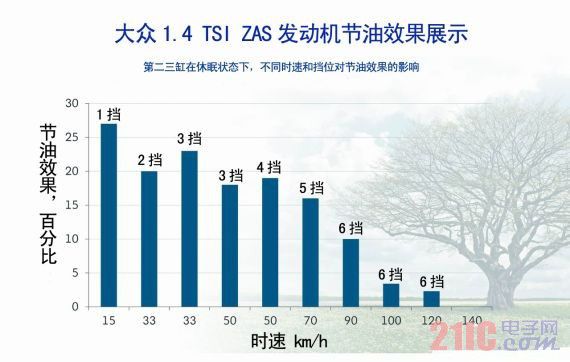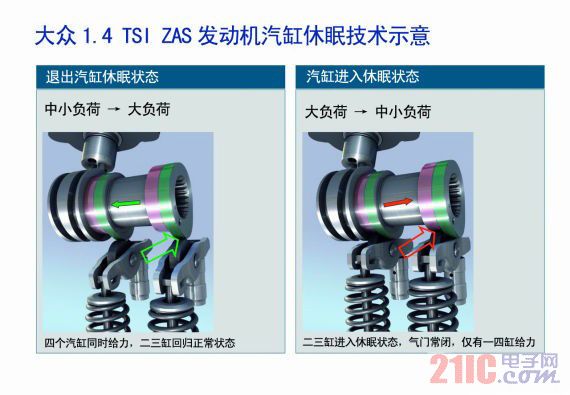Volkswagen will introduce ZAS cylinder dormancy (variable displacement) technology for inline four-cylinder gasoline engines to further reduce fuel consumption and emissions after introducing in-cylinder direct injection, stratified combustion and turbocharging technologies. The first engine to use cylinder sleep technology will be our familiar 1.4 TSI. The Volkswagen ZAS system will automatically stop and stop ignition of the two cylinders under low and medium load conditions and keep the valve closed. The first 1.4 TSI engine using ZAS technology is expected to be released in early 2012.
This article refers to the address: http://
Volkswagen said that according to European fuel consumption test standards, the 1.4-liter TSI engine will reduce fuel consumption by 0.4 liters per 100 kilometers after using ZAS cylinder sleep technology. In some specific driving conditions, up to 1 liter of fuel can be saved in a hundred kilometers. Volkswagen will be the first automaker to introduce cylinder sleep technology into mass-produced turbocharged four-cylinder engines.

Volkswagen 1.4 TSI ZAS cylinder sleep technology
How does the Volkswagen cylinder sleep system work?
Volkswagen's engine cylinder sleep system switches the working cams of the second and third cylinders through a complex control mechanism to control the operating conditions of the second and third cylinders. There are four sets of camshaft control mechanisms, two sets are installed on the intake cam and the exhaust cam, and eight valves of the second cylinder and the third cylinder are controlled. The cam shafts of the second cylinder and the third cylinder are hollow shafts through which the cam shafts of the first cylinder and the fourth cylinder pass, and the spokes are used to drive the cam shafts of the second cylinder and the third cylinder to rotate together. Since the spline connection is employed, the second cylinder and the third cylinder cam shaft can move left and right on the cam shafts of the first cylinder and the fourth cylinder in the axial direction.

1.4 TSI ZAS cylinder sleep technology works
Next to each of the conventional cams on the second and third cylinder camshafts is a zero lift cam (i.e., circular) having the same radius as the camshaft base circle. When the conventional cam is in contact with the needle bearing on the rocker arm, the valve will achieve a normal opening and closing action. When switching to the zero lift cam, the valve is normally closed.
The aforementioned camshaft control mechanism controls the left and right positions of the second cylinder and the third cylinder camshaft through a cylindrical cam on the second cylinder and the third cylinder camshaft, thereby realizing switching between the conventional cam and the zero lift cam . While the camshaft control mechanism is switched to the zero lift cam, the engine control system shuts off the fuel supply and enters the two-cylinder operating mode. Conversely, when switching to the conventional cam, the fuel supply is restarted and the four-cylinder operating mode is entered. This means that switching from two-cylinder to four-cylinder or from four-cylinder to two-cylinder requires only a 180-degree rotation of the camshaft, which takes about 13 to 36 milliseconds depending on the engine speed and is also used throughout the switching process. With the adjustment of the ignition system and the throttle.
The engine control system determines the driver's intention through the signal of the accelerator pedal sensor. If the accelerator pedal changes frequently, such as on a winding road, or driving on a spacious, unobstructed road, the engine control system will not go to sleep. The Volkswagen Engine Sleep Control System has a total mass of only 3 kg and is extremely compact. The control mechanism, camshaft and camshaft support are all located inside the engine head cover.
Reduce fuel consumption by up to 1 liter
According to the NEDC European comprehensive fuel consumption test mode, the fuel consumption measured by the new 1.4 TSI engine shows that after the engine automatic dormancy technology, the fuel consumption per 100 kilometers is reduced by 0.4 liters, and the carbon dioxide emissions per kilometer are reduced by 8 grams. If the engine automatic start/stop control system is installed and the engine is turned off while the gearbox is in the neutral state, the fuel consumption per 100 kilometers will be reduced by 0.6 liters. The engine sleep system has the best fuel economy when the car is at medium speed and constant speed cruise. When the speed is 50 km / h, when using the third or fourth gear cruise, the fuel consumption per 100 kilometers will be reduced by 1 liter due to the engine sleep system. With a five-speed cruise at 70 km/h, the fuel consumption per 100 km can still be reduced by 0.7 liters.
With the help of a turbocharged system, the new 1.4 TSI engine has a peak horsepower output of 140 ps and a maximum torque of 250 Nm between 1,500 rpm and 4,000 rpm, which meets Euro 6 standards.
The engine has excellent output characteristics
When the 1.4 TSI engine speed is between 1,400 rpm and 4,000 rpm, the engine cylinder sleep control system can be started, and the engine torque output in the two-cylinder state will be reduced by 25 Nm to 75 Nm compared to the four-cylinder state. In the European fuel economy test, about 70% of the test distance, the cylinder sleep control system is working, that is, only two cylinders work. First, the combustion chamber is filled with air that keeps the cylinder pressure to a minimum, thereby reducing energy losses. Secondly, after the cylinder sleep control system closes the intake and exhaust valves of the second cylinder and the third cylinder, the crankshaft only fires once per revolution. The pistons of the two cylinders that are dormant are driven by the crankshaft, and the first and fourth cylinders in operation increase the working efficiency because they have a higher working load.
Cylinder sleep has little effect on NVH
The driver can only detect whether the engine cylinder is in a sleep state by adjusting the driving computer to the instantaneous fuel consumption display state. Otherwise, it will be difficult to detect the operation of the system, whether it is two cylinders or four cylinders. The new 1.4 TSI engine has excellent running balance and is quiet and smooth even in two-cylinder operation.
Pedal Dustbin,Stainless Steel Pedal Dustbin,Stainless Steel Foot Pedal Dustbin,Pedal Toilet Dustbin
NINGBO ZIXING ELECTRONIC CO.,LTD. , https://www.zixingautobin.com
